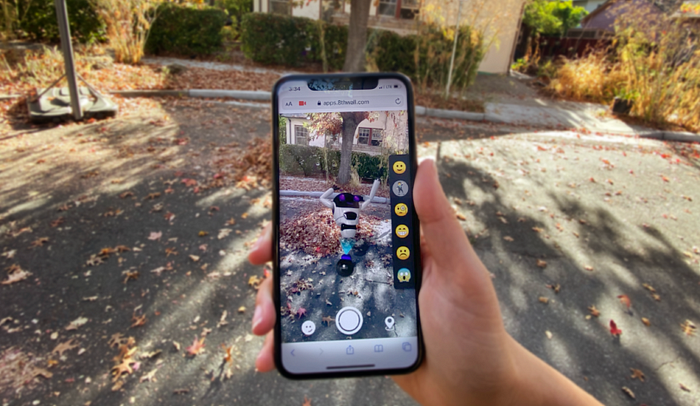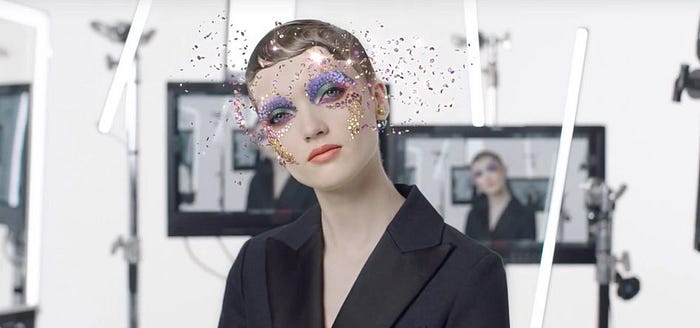20 for 2020: Augmented Reality Trends and How They May Play Out This Year

2020 has arrived! What can we expect for augmented reality as we enter the first year of this brand new decade? These are the 20 AR trends I will be watching and how they may play out this year.
Want a recap of what happened in AR in 2019? Read my “Reality Check” post which looks back at the 19 trends I highlighted for 2019 and how they actually played out last year.
Industry
#1 The AR industry swallows its Jagged Little “Reality” Pill as it pushes the mainstream AR eyewear target out a couple of years

Despite how perfect it would have been to see a huge win in consumer AR smartglasses in 2020 (20/20 vision, get it!), this year the AR industry is forced to take its head out of the “AR Cloud” and come to terms with just how hard it is really is to usher in our wearable AR future. Originally anticipated for 2020, the debut of a pair of AR glasses that would win over the masses is now being pushed out as far as 2023 for some. The good news is that when we stop staring at the stars, we will begin to see the remarkable wins that will happen this year that are making AR a reality for consumers today.
Hardware
#2 Smartphones are becoming even more powerful AR machines with spatial sensors that will unlock advanced AR use cases

The device that we have been carrying around with us for the past decade is already capable of augmented reality but this everyday device is getting new chips and sensors which will make it an even more powerful AR machine. This year we will see advanced spatial sensors such as ToF (time-of-flight), radar and ultra wideband become a smartphone staple. These sensors will enable next level AR experiences, new content creation capabilities using 3D scanning and new ways for your phone to interact with the world around you.
2020 smartphones will also sport powerful chips and processors designed to power immersive experiences. And we will also see more phones with foldable screens which will dramatically improve the field-of-view for smartphone AR experiences while keeping these devices small enough to fit in our pocket.
But it isn’t just the smartphone to watch this year but also the tablet. The new iPad Pro may be marketed as the perfect AR machine with a 3D-sensing rear camera, a powerful A13+ processor and possibly new display technology which will help the device be lighter than ever.
#3 Consumers will get more smartglasses options than ever but value propositions will remain unclear

In 2019 we saw just a few connected eyewear options for consumers. This year, consumers will have a lot more devices to choose from, possibly even some from luxury fashion brands. These devices will be the most fashionable and wearable we have seen, with sleeker and lighter designs offered in various colors and styles and even bendable arms like real glasses. To achieve this, they need to rely on the processing power of the smartphone making them more of a smartphone accessory rather than a replacement. AR eyewear as an accessory is a great go-to-market strategy for consumers whose smartphones sit at the center of their modern day life.
While we will see advanced hardware hit the shelves, what may be missing are clear use cases to convince consumers to purchase and wear the device. This fuzzy value proposition and higher than desired price point will greatly limit consumer adoption, narrowing it to early adopters and enthusiasts. To help define value, the device manufacturers will look to the developer community. The apps created, and the user interest expressed this year, will help pave the way for consumer AR smartglasses to succeed tomorrow.
#4 Advancements in optics will enable “good enough” AR glasses to be made while showing us how far away we are from true all-day AR eyewear

The optics and photonics community are literally trying to break the laws of physics to give us the components we need to create fashionable all-day AR glasses.
This year we will see waveguides combiners get thinner and more efficient, offer a “good enough” field-of-view and become manufacturable in high volumes at consumer-level costs, thanks to an entire industry ecosystem coming together to allow such developments. Quantum dots and microLEDs will offer brighter and more energy-efficient displays lengthening battery life and reducing the need for bulky projectors which generate a lot of heat. Meanwhile, waveguide grating alternatives, such as reflective pin mirror lightguides, are getting ready to move out of the concept phase.
As monumental as these advancements are, they also shine a light on just how hard it is to build AR glasses. To quote Michael Abrash, “The honest truth is that the laws of physics may make it impossible to ever build true all-day AR glasses; there’s no Moore’s Law for optics, batteries, weight, or thermal dissipation.”
#5 VR headsets are getting all the right ingredients for stereo video passthrough making it a trojan horse for headworn AR

Virtual reality devices are beginning to double as AR headsets thanks to stereo video passthrough. Next generation VR devices are getting updated with all the necessary ingredients to make video passthrough possible including high resolution displays, powerful cameras, depth sensors, GPUs and eye-tracking. The combination of these ingredients are solving for some of the biggest challenges video passthrough faces such as latency. As we wait for optical see-through devices to improve, VR devices with stereo video passthrough will deliver headset AR with the widest field-of-view and visual fidelity with the bonus of true “mixed reality”. This year will see a lot of activity in video passthrough both aimed at the enterprise and at the consumer.
#6 More organizations will launch customized AR headsets to better suit the needs of their industry

Reference designs from Flex, Qualcomm and Microsoft offer the enterprise the resources they need to create AR headworn devices that meet the specific needs of their industry. We have already seen Trimble customize the HoloLens for the construction industry and the military make its adjustments for the army. This year, we may see even more organizations leverage the lessons they gained from AR headworn pilots to customize these devices to meet the specific nuances of their industry and in turn maximize the upskilling of their workforce.
#7 Holographic imagery will deliver a new kind of AR to the masses creating out of this world experiences with no user device required

2020 will be a big year for holographic projection and displays, an AR category which doesn’t require the user to have a headworn or handheld device. Projection mapping, light field and eye-sensing 3D displays and pepper’s ghost solutions will be on the rise especially for large scale events and venues such as stadiums, concert halls, theaters, museums, malls and airports. These technologies will especially be key for the retail industry which is currently undergoing an experiential transformation to meet the demands of the experience economy. They will also normalize the occurrence of “holograms” which are already performing on stage and greeting travelers at the airport.
While most of these technologies will be experienced by consumers in large spaces, we may also see somewhat affordable consumer solutions offering users a new way to experience memories and way to bring their virtual assistants to life.
This “in your face” augmented reality category will introduce many to the wonder and awe of AR which will have a direct impact on the adoption of mobile and eventual “on your face” options.
#8 Hearables will continue to be the dominant consumer wearable but most won’t be equipped to deliver audio AR

2020 will be another great year for hearables with AirPods continuing to lead the charge. The growing adoption of wearables, including hearables and smartwatches, is a very positive thing for headworn AR as the masses continue to get comfortable with wearing tech on their body and face. I suspect this will be an incremental year for most hearables as they gain new sensors for fitness tracking, improved noise cancellation and enhanced access to digital assistants. But lack of access to this platform by developers, including its sensors, limit its augmented audio potential (Bose AR being the exception).
Platforms, Tools & Infrastructure
#9 2020 will be a huge year for the immersive web as developers look to the browser for reach and adoption

With standards and browser updates gradually rolling out and development platforms like 8th Wall making it possible to build WebAR experiences using popular web frameworks, the web is becoming a powerful destination for augmented reality.
2020 will be a significant year for WebAR as developers look to the open web as a frictionless way to engage users at scale. The ease, accessibility and reach of the web makes it an ideal place to create and update immersive content in real time. This year will see an influx of AR content populate the web as developers push the limits of WebAR to create complex and meaningful content that is just a tap of a link away.
#10 Capture solutions and studios will equip creators with ways to create 3D content to use in AR

A wide variety of 3D scanning solutions leveraging the smartphone camera will offer users a way to capture themselves, objects and the world around them. 3D assets are essential ingredients to create immersive experiences and while the quality of these early captures may leave room for improvement, acclimating users to a new form of content creation to increase the inventory of 3D assets will be a big win.
Meanwhile, capture studios, which are popping up around the world, will offer agencies and brands a higher quality method to create volumetric video of people to be used in AR, VR and 3D experiences.
Beyond capture, the end-to-end 3D asset pipeline including optimization and management will be a critical focus in 2020.
#11 Social AR filter creators will shift focus from face to body to give users special effects to supercharge their video storytelling

With face filters now a commodity and an army of filter creators ramped up on creating AR for the face, social AR platforms and their creators will shift their focus to body filters (as well as world filters). Body AR templates are already available yet under utilized in platforms like Lens Studio and Spark AR. One influencing factor here is TikTok, which we may see open itself up more to filter creators this year. TikTok’s full body video skits are the perfect place to play with body AR, equipping TikTokkers with special effects to supercharge their videos. Expect your Stories to be filled with your friends throwing fireballs, dancing with characters and more this year as body filters take over your feeds.
#12 The AR Cloud will rain 5G again this year as carriers use large scale AR activations to market networks that are getting ready

2019 was filled with a lot of buzz about 5G and 2020 will be no different. While carriers and device manufacturers are getting ready to unlock this new network to the masses, they will use 2020 to market ways in which 5G will change our lives, including enabling AR and VR. A perfect fit for these activations is the AR Cloud which will power stadium and city-scale AR for limited audiences as way to market the power of 5G in a demonstrable way.
Investments
#13 2020 will be a big year for M&A as big players look to secure their lead in the spatial computing race

2020 is poised to be a big year in AR/VR for M&A. With many AR startups with years under their belt, their teams, tech and traction are at a prime place for acquisition. This makes them great targets for both by larger tech players and large solution providers who are bullish on the next wave of computing and are looking to secure their lead in the AR race.
Consumer AR Solutions
#14 Marketers will increase their spend on augmented reality as they embrace AR as the ad format of the experience economy

Marketers have always been one of the first to adopt emerging technologies. We saw a number of advertisers take advantage of AR last year as new channels became available such as Facebook’s AR ads in the News Feed, Instagram’s launch of Spark AR Filters and 8th Wall’s markerless and image target WebAR. But this year will see the floodgates open for AR advertising as more ad networks and ad formats become available and more budget is allocated to AR as a compelling advertising medium suited to meet the new demands of users in the experience economy.
In addition, I suspect that we will start to to see standards, benchmarks and case studies emerge to help marketers build better campaigns and demonstrate key metrics which highlight how AR can achieve campaign goals.
#15 AR will unlock “phygital” retail as consumers expect to try things on virtually and scan all things as part of their shopping experience

AR-commerce will be extremely active this year, as major players such as Instagram and YouTube continue to ramp-up virtual try-on as a core feature of the online buying experience. Trying online products like you would in physical retail will also benefit from WebAR solutions, such as those from 8th Wall and Apple’s QuickLook, which integrate seamlessly within existing web purchase flows.
Meanwhile, consumers will begin to expect they can scan any product in the real world with their phone to generate a digital result, AR experience or digital information, thanks to the growing use of Google Lens and Snapchat’s Scan and a sea of QR codes they find on magazines, product packaging, and signage.
#16 Filters will continue to influence the fashion and beauty industry while slowly becoming the future of it all at the same time

AR filters are changing the fashion and beauty industry. As expected, the industry is using filters to let consumers try things on virtually before they buy. But they are also using filters as part of a complete look, with virtual makeup and virtual clothing taking it to a whole new level. Fashion and beauty houses are also finding inspiration from filter creations to create AR-inspired makeup, hair and clothing which are walking the runway and setting this year’s trend (such as L’Oreal’s choice of “Holographic” as the hair color of 2020).
In the meantime, individuals are using filters to express their own style and identity either by creating their own filters or using filters published by creators. Choosing a filter is becoming just as everyday as choosing what you are going to wear today or what makeup to wear. And in some cases filters are replacing the physical application altogether — choosing to apply a filter instead of a full face of makeup when livestreaming or recording a video. Filter creators are becoming the new “designers” , gaining followers for their filter “collections” and being credited for their looks in music videos and user Stories.
This year will surely see more of the existing beauty and fashion industry tap into the power of filters, which may include exclusive luxury brand filters. At the same time we will witness a new beauty and fashion industry emerge.
#17 Your digital self will escape from the walled garden it grew up in letting you “see” yourself in new places and stories

This year will be a big year for avatars. We already saw Snap double down on Bitmoji with Bitmoji TV where your avatar stars in a weekly Saturday cartoon. This is just the start of your mini Me engaging in digital worlds. I suspect this year we will see some major moves from Facebook , Snapchat, Samsung and Apple as they all vie to win the avatar war and update their platform with new ways to use them. This may include the ability to use your avatar in various apps, not just the one you create it in, including AR experiences where “you” can be seen as part of the action (you wearing those shoes or you running through the fields with a dinosaur, for example). We may also soon be able to opt to show our avatar self instead of our real self when someone goes to take a picture or a video.
#18 Navigation and geo-based experiences will be on the rise this year helping users get from A to B in a brand new way

Helping people discover and get to places is a killer feature of AR. Luxury vehicles including Mercedes, Cadillac and Hyundai now include augmented reality navigation systems. Google Maps now features AR walking directions with expanded support and new features rolling out soon. And this is just the beginning.
2020 will see other smartphone apps that currently use 2D maps to help users discover and navigate places around them differentiate by offering an AR alternative (think Trip Advisor, Yelp, Apple Maps, Uber etc.). But AR won’t just be used outdoors. Indoor wayfinding in larger venues such as malls and airports are prime to deliver value to users this year and could make use of the new spatial sensors being made available in the latest phones.
But just making it easier to get from one place to another is not all AR will bring to the table. Geo-based AR experiences will be popular this year, including the use of AR to gamify a day at the mall or a walk to the nearest cafe by making them apart of a scavenger hunt and games like Pokemon Go.
Enterprise AR Solutions
#19 After engaging in pilots, organizations look for full solutions that can integrate with existing systems and be rolled out at scale

AR has been very busy at work. Over the past few years, we have heard many powerful stories from various organizations who have been piloting AR solutions to upskill their workforce, resulting in efficiencies upwards of 40% and more. The ROI for AR in the enterprise is substantial and it more than justifies the cost of headworn devices. But moving from pilot to full rollout is challenging and requires a different set of ingredients to succeed. This year, organizations in various industries will look to implement full solutions that consider safety, security, integration with existing systems and processes, and scalability. Vendors that can solve for all the above will be well positioned to succeed.
Ethics & Culture
#20 Growing distrust and fear around tech issues like facial recognition and deep fakes will demand new regulations and social contracts which will shape future AR

Fear and distrust around the collection and use of online information and the validity of online content will continue to dominate the tech conversation this year. Safety and trust are paramount for all tech solutions, but are especially key for AR where computers sense and edit the world around us. Early decisions by tech companies on issues like facial recognition and deep fakes and the subsequent reactions of its users will demand new regulations and social contracts to emerge. The paradigm shifts created today will greatly shape the AR of tomorrow.
This article was written as an independent piece. The ideas and opinions expressed in this post are mine alone and do not represent any organization which I may be affiliated with.
Have other trends that you are watching in AR? Leave them in the the comments below.
Follow me on Twitter @TomEmrich to get the latest AR news and to be notified when my next Medium Post goes live including my monthly “The AR Roundup”.
Thanks for reading!
